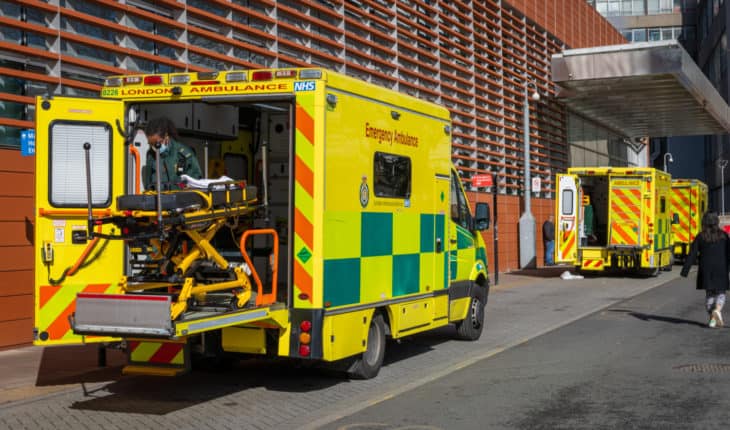Nearly two thirds of A&Es across the UK had ambulances waiting to transfer patients every day in the past week, according to a new survey from the Royal College of Emergency Medicine.
The latest RCEM survey covers the period 8 November to 14 November 2021 and was sent to Clinical Leads in Emergency Departments across the UK and received 70 responses.
The NHS mandates that ambulance handovers ought to be reliably completed within 15 minutes of arrival, but 61% of Emergency Departments in the survey were struggling to meet this standard every day.
The survey also found that over half of Emergency Departments had provided care to patients in non-designated areas such as corridors every day in the past week.
These findings come following a report by the Association of Ambulance Chief Executives (AACE) which found that 160,000 patients may be coming to harm annually as a result of ambulance handover delays.
While a separate report by the Royal College of Emergency Medicine, ‘Crowding and its Consequences’, found that at least 4,519 patients have died as a result of dangerous crowding in Emergency Departments in England in 2020-2021.
The Royal College’s survey also found
- 14% of respondents stated that the longest stay they had had in their Emergency Department was between 48 and 72 hours
- 36% of respondents stated the longest stay in their Emergency Department was 24 to 48 hours
- 39% of respondents stated the longest stay in their Emergency Department was 12 to 24 hour
- 14% of respondents stated that there was no effective Same Day Emergency Care available in their Emergency Departme
- 50% of respondents stated that Same Day Emergency Care had limited availability, less than 12 hours a day or weekdays only in their Emergency Departmen
- 71% of respondents stated that they were unable to maintain social distancing for patients in their Emergency Department in the past week
Dr Katherine Henderson, President of the Royal College of Emergency Medicine, said:
“These results show the serious state that our urgent and emergency care system is in. None of us want to have patients held in ambulances, treated in corridors, or waiting very long times to go up to a ward bed. Sadly, these findings support our stark report on crowding and the AACE’s shocking report on ambulance handovers.
“We all need to work together to solve this acute patient safety problem. We believe enacting many of the suggestions we have made in RCEM CARES: The Next Phase will help. We want patients to feel confident that their Emergency Care system is there for them, but this winter is going to be a huge challenge unless we can get flow back into the system.
“RCEM CARES: The Next Phase details our system-wide plan to tackle the current crisis and improve patient care as well as staff wellbeing. In the short-term, to promote flow and to reduce handover delays, capacity must be expanded in a safe way. Same Day Emergency Care must be made available at all Trusts and they must expand its provision, so it is available 12 hours a day, seven days a week. While maximising the service Discharge to Assess will allow patients to be discharged in a timely and supported way.
“In the long-term, we urge the government to publish a long-term workforce plan, this must include actions to retain existing staff as well as recruit new staff. Across the UK there is a shortfall of 2,000-2,500 WTE Emergency Medicine consultants, and crucially, there are also widespread shortages of Emergency Medicine nurses and both junior and supporting staff. At the same time capacity is severely depleted across the UK. The government must restore bed capacity to pre-pandemic levels, this requires an additional 7,170 beds across the UK.
“This is only the beginning of winter and of what may come. We are facing a crisis in urgent and emergency care and a crisis of patient safety. The Secretary of State in the House of Commons spoke of ‘a duty to avoid preventable harm of everyone working in health and social care’, we urge him to act on his own words and prevent avoidable harm and ensure the safety of patients.”
Managing Director of AACE Martin Flaherty OBE QAM said:
“These alarming new figures from RCEM underline once again the unprecedented pressures facing the entire urgent and emergency care system.
“We now know that excessive handover delays and crowding in A&E departments are routinely harming patients, some very severely. To resolve this, we need system leaders to further toughen their resolve to deal with this problem once and for all and as a matter of priority and we await details of progress being made in this area, while underlining our commitment to work as part of the solution to this complex issue.”
Tracy Nicholls, Chief Executive of the College of Paramedics, said:
“We must not forget that behind all these mounting figures are real people, both staff and patients, who are bearing the brunt of this continuing strain on services.
“Reform must happen to alleviate the intolerable pressure and reduce the guilt many paramedics and Emergency Department staff feel about dealing with patients who are waiting outside Emergency Departments or, more worryingly, in the community.
“We support any efforts to deal with the here and now, but we commit to working with stakeholders and partners to make real change happen.”
- New lipid-based pathway discovered as key to memory formation - 25th June 2025
- Crucial link could explain how Alzheimer’s takes hold - 25th June 2025
- Understanding Your Mind Can Improve Daily Life - 25th June 2025






